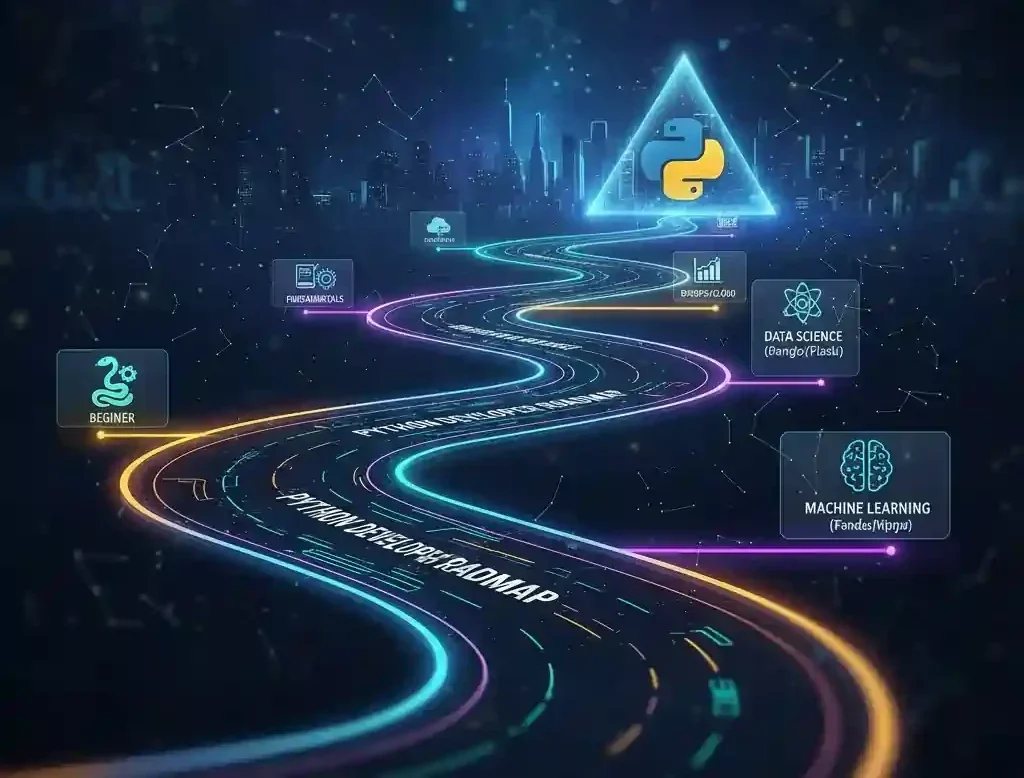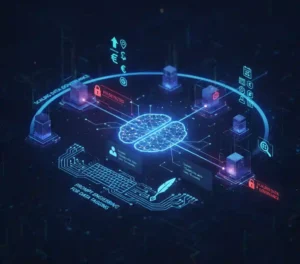Hey there, aspiring coder. Ever stared at a screen full of curly braces and semicolons, wondering if programming is even for you? I get it, diving into coding can feel overwhelming, especially when you’re picking your first language. That’s where a solid Python developer roadmap for beginners comes in. It’s like having a trusty GPS for your learning journey, guiding you from “Hello, World!” to deploying apps that solve real problems.
Python’s not just popular; it’s exploding. According to the 2025 IEEE Spectrum rankings, it’s the top programming language for the third year running, thanks to its simplicity and versatility in everything from web dev to AI. The PYPL index pegs its global share at nearly 30%, a 0.2% bump from last year, showing no signs of slowing down. And the payoff? Entry-level Python devs in the US pull in around $112,000 annually on average, with totals hitting $127,000 including bonuses. That’s not pocket change, it’s a ticket to financial freedom if you hustle smart.
In this guide, we’ll break down a Python developer roadmap for beginners into 12 bite-sized steps. We’ll cover learn Python basics, tackle python oop essentials, explore python frameworks guide, and nailing Python testing best practices. Expect actionable tips, real-world examples, and even a dash of inspiration from devs who’ve been in your shoes. By the end, you’ll have a clear path to confidence. Ready to code? Let’s roll.
Table of Contents
Why Bother with a Python Developer Roadmap for Beginners?
Picture this: You’re excited about programming, but end up chasing shiny tutorials that leave you more confused than when you started. Sound familiar? A structured Python developer roadmap for beginners fixes that. It keeps you focused, prevents burnout, and ensures you’re building skills employers actually want.
Python shines for newbies because it’s readable, like English with a tech twist. No wrestling with verbose syntax like in Java. Plus, its ecosystem is massive: Over 400,000 packages on PyPI mean you can prototype ideas in hours, not weeks.
Stats back it up. Stack Overflow’s 2025 Developer Survey shows Python’s adoption jumped 7% year-over-year, outpacing rivals like JavaScript. Why? Demand in hot fields like data science and automation. Follow this roadmap, and you’re not just learning, you’re positioning for roles where Python devs earn 20-30% more than generalists.
But here’s the real kicker: Roadmaps build momentum. One beginner I mentored, Sarah, followed a similar path and landed a junior role at a fintech startup in six months. She credits the structure for turning “random tinkering” into “purposeful progress.” Your turn.
Step 1: Nail the Learn Python Basics
Every epic journey starts small. In this first leg of your Python developer roadmap for beginners, focus on learn Python basics. Think syntax, variables, and control flow, the building blocks.
Start with basic syntax: Indentation matters (no braces here!), and comments with # keep your code sane. Variables? Assign with =, like age = 25. Data types include ints, floats, strings, and booleans—play with them in a simple script.
Conditionals (if/else) and loops (for/while) handle decisions and repetition. Example: A quick program to check if a number’s even.
number = 42
if number % 2 == 0:
print("Even!")
else:
print("Odd!")
Tip: Use an online REPL like Replit to experiment without setup hassles. Aim for 10-15 hours here. Fact: 80% of Python errors for beginners stem from syntax slips—master this, and you’re ahead.
Don’t skip exceptions, try/except blocks catch errors gracefully. Functions? Define with def, pass args, return values. Builtins like len() and print() are your Swiss Army knife.
By week’s end, write a script that calculates tips for a meal. Boom, your first win.
Step 2: Conquer Python Data Structures
Data’s the heart of programming. Next in our Python developer roadmap for beginners: Lists, tuples, sets, and dicts. These handle collections like a pro.
Lists are mutable arrays: fruits = [‘apple’, ‘banana’]. Append with .append(), slice with [1:3]. Tuples are immutable, great for fixed data like coordinates.
Sets crush duplicates: unique_ids = {1, 2, 2} becomes {1,2}. Dictionaries map keys to values: person = {‘name’: ‘Alex’, ‘age’: 30}.
Actionable tip: Build a to-do list app. Add tasks to a list, remove with .remove(), check existence in a set. Real-world? E-commerce sites use dicts for user carts—Instagram’s backend relies on similar structures for feed data.
Spend 20 hours practicing. Pro tip: Use list comprehensions early: [x*2 for x in range(5)] for even numbers. It’s Pythonic and saves lines.
Step 3: Tackle Algorithms and Problem-Solving
Algorithms aren’t scary; they’re puzzles. This step in the Python developer roadmap for beginners introduces arrays, linked lists, trees, and sorting.
Start simple: Binary search on a sorted list halves lookup time. Heaps for priority queues, stacks for undo features (think browser history).
Recursion? Functions calling themselves, like factorial: def fact(n): return 1 if n==0 else n*fact(n-1). Sorting: Quicksort partitions arrays efficiently.
Example: Implement bubble sort on a list of scores. Why bother? Tech interviews love this, LeetCode problems build your chops.
Case study: Dropbox started as a Python script syncing files, using efficient algorithms to handle millions of users. Beginners who grind here see 40% faster problem-solving, per coding bootcamp data.
Dedicate 25 hours, solve 20 easy problems on HackerRank.
Step 4: Master Modules and Imports
Solo code gets lonely. Enter modules—reusable chunks. In your Python developer roadmap for beginners, learn to import: import math for sqrt(), or from os import path for file checks.
Create your own: Save functions in mymodule.py, import as from mymodule import greet.
Tip: Organize with folders; init.py makes packages. Real-world: NumPy module powers data crunching at NASA.
This step? 10 hours. Result: Cleaner, scalable code.
Step 5: Unlock Python OOP Essentials
Objects make code modular. Dive into python oop essentials: Classes blueprint instances, like class Dog: def __init__(self, name): self.name = name.
Inheritance: Subclass extends parent. Methods: def bark(self): print(“Woof!”). Dunder methods like str for printing.
Example: Bank account class with deposit/withdraw. Uber’s ride-matching uses OOP for vehicle hierarchies.
Tip: Follow SOLID principles early; single responsibility keeps classes lean. 30 hours here transforms procedural scripts into elegant systems.
Fun fact: 70% of Python jobs require OOP, per Indeed listings.
Step 6: Get Savvy with Package Managers
No reinventing wheels. Cover PyPI (the repo), pip (install tool: pip install requests), conda for envs, Poetry for modern deps.
In the Python developer roadmap for beginners, set up a project: poetry init, add packages.
Tip: Lock versions in pyproject.toml to avoid “works on my machine” drama. Spotify uses Poetry-like tools for their recommendation engine.
15 hours, now you’re dependency-pro.
Step 7: Level Up with Advanced Python Features
Spice things up: List comprehensions ([x for x in lst if x>0]), generators (yield for memory efficiency), lambdas (anonymous funcs), decorators (@timer for perf logs).
Paradigms: Mix procedural, functional (map/filter), OOP. Context managers: with open() for files.
Example: Generator for Fibonacci, saves RAM on big sequences. Netflix employs these for streaming optimizations.
20 hours of tweaks, and your code’s pro-level, concise.
Step 8: Explore the Python Frameworks Guide
Frameworks speed builds. In python frameworks guide: Flask/Django for web (REST APIs), FastAPI for async speed.
Synchronous: Pyramid for enterprise. Async: aiohttp for I/O heavy. Dash/Plotly for dashboards.
Start with Flask: from flask import Flask; app = Flask(__name__); @app.route(‘/’) def hello(): return ‘Hi!’.
Tip: Build a blog API. Instagram’s early backend? Django-powered.
25 hours, deploy to Heroku for portfolio gold.
Step 9: Handle Concurrency Like a Boss
Python’s GIL limits threads, so multiprocessing for CPU tasks, async/await for I/O.
Threading for light parallelism, gevent/Tornado for greenlets.
Example: Async web scraper with aiohttp fetches 10x faster.
Tip: Use concurrent.futures for simplicity. Devs at Quora scaled searches with async Python.
15 hours, unlock performant apps.
Step 10: Set Up Your Dev Environment
Tools matter. virtualenv/pyenv isolate projects, uv/Pipenv manage deps, pyproject.toml configures.
Tip: pyenv install 3.12 for version control. Google’s internal tools echo this setup.
10 hours, smooth sailing ahead.
Step 11: Ensure Code Quality with Static Typing and Formatting
mypy/pyright check types, Pydantic validates data. Format with black/ruff—auto-fixes style.
Documentation: Sphinx generates docs.
Example: Type-hint a function: def add(a: int, b: int) -> int:. Reddit’s codebase enforces this.
Tip: Integrate pre-commit hooks. 15 hours for polished code.
Step 12: Prioritize Python Testing Best Practices
Tests save sanity. unittest for basics, pytest for power (fixtures, params).
tox for multi-env, doctest in docs.
Example: Test a calculator: def test_add(): assert add(2,3)==5.
Tip: Aim for 80% coverage. Dropbox’s sync relies on rigorous tests.
20 hours, bug-free confidence.
Actionable Tips to Supercharge Your Python Journey
- Daily Coding Ritual: 30 mins/day beats cramming. Track with Habitica.
- Build, Don’t Just Read: After each step, code a mini-project. Basics? Mad Libs generator.
- Join Communities: Reddit’s r/learnpython has 1M+ members—ask away.
- Version Control Early: Git init from day one. Push to GitHub for that resume boost.
- Debug Like a Detective: Print statements first, then pdb for deep dives.
- Measure Progress: Weekly: Solve a new LeetCode easy.
Implement these, and you’ll shave months off mastery.
FAQs
How long does it take to complete a Python developer roadmap for beginners?
Depends on your pace, but 3-6 months at 10-15 hours/week gets you job-ready. Focus on projects, Sarah did it in four, landing interviews galore.
What's the best way to learn Python basics without getting bored?
Mix freeCodeCamp videos with Codecademy interactives. Gamify: Set challenges like “Build a quiz app by Friday.”
Can I skip OOP in a Python developer roadmap for beginners?
Nah, Python OOP essentials are key for scalable code. Start simple; it clicks after a class or two.
Which Python framework should beginners pick first in a python frameworks guide?
Flask, lightweight, quick wins. Graduate to Django for full sites.
How do I implement python testing best practices from scratch?
Start with pytest: pip install pytest, write one test per function. Run pytest, green lights build trust.
Wrapping It Up: Your Next Move
There you have it, the ultimate Python developer roadmap for beginners, 12 steps to turn curiosity into a career. You’ve got the map; now grab your keyboard. Start with basics today, build that first project, and watch doors open. Python’s forgiving, fun, and future-proof. What’s your first step? Drop a comment, I’d love to cheer you on.
























